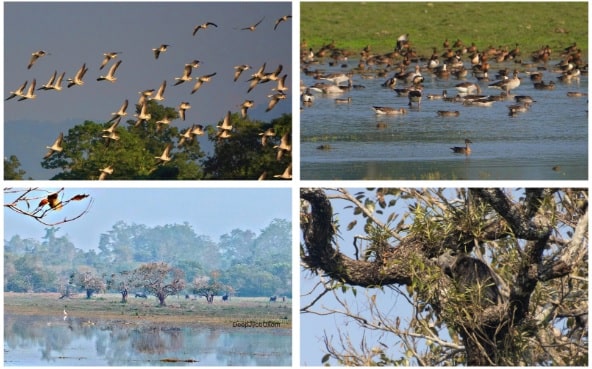

Kaziranga National Park and Tiger Reserve announces the preliminary results of the 5th Kaziranga Tiger Reserve Water-bird Count cum Festival conducted on 9-10 January, 2024. Shri Chandra Monhan Patowary, Hon’ble Minister, Department of Environment and Forest, Government of Assam inaugurated the Bird Census cum Festival on 9th January 2023 at Agoratoli, Kaziranga. On 10th January, 2024, simultaneous bird census was conducted across 115 water bodies spread across the 3 divisions of Kaziranga Tiger Reserve.
The census revealed the presence of 84,839 birds which is a 27% increase since the last count (66,776 in 2021-22). This places Kaziranga among the top-5 in the county in terms of presence of resident and winter-migratory birds.
A summary of the results is given in the table below: -
|
Range/ Division |
Total Beels |
Total Enumerators |
Total Volunteers, Forest Officials & Staff |
Total Species* |
Total no. of Individuals |
|
Eastern Assam Wildlife Division |
83 |
56 |
183 |
155 |
37606 |
|
Nagaon Wildlife Division |
24 |
25 |
105 |
98 |
35231 |
|
Biswanath Wildlife Division |
8 + River bank |
27 |
66 |
82 |
12002 |
|
|
115 |
108 |
354 |
- |
84839 |
*Total species listing needs further data analysis and verification.
Salient Features of the 5th Water-Bird Census vis-a-vis Previous Bird Censuses
The Eastern Assam Wildlife Division, comprising mostly of the Kaziranga National Park area, recorded 37606 birds and the highest abundance of a single species (Bar-headed Goose) was recorded at Sohola Beel (13084 individuals). Rowmari beel under Nagaon Wildlife Division recorded the highest number of birds across all wetlands (19301 individuals). Under this Division, (Laokhowa and Burhachapori Wildlife Sanctuaries and Joysagar Doloni of Kaliabor) the highest abundance of birds recorded was of Northern Pintails (8960 individuals).
Under Bishwanath Wildlife Division, the highest abundance of birds (2727 individuals) was reported under Dipora Area under Eastern Range Gamiri followed by 2520 individuals at Kutainee beel under Western Nagshankar Range.
Importance of Wetlands Outside Kaziranga NP&TR
During the 5th KTR Water-bird Census, it was decided to carry out census in major wetlands adjoining the Tiger Reserve along with the wetlands falling inside the Reserve. The Kaziranga-Hukuma beel in Biswanath recorded 3049 birds while the Joysagar Doloni in Kaliabor recorded 1765 birds highlighting their conservation and protection. Other notable wetlands adjoining the Tiger Reserve that recorded significant bird presence were Gonak beel (973 individuals), Sahala beel (424 individuals) and Sisubari beel (348 individuals).
There are over 200 wetlands across the Kaziranga Tiger Reserve and a significant area of the Brahmaputra River and its tributaries are protected as part of the 6th Addition of Kaziranga National Park and 1st Addition of Burhachapori Wildlife Sanctuary. The results of the 5th KTR Water-bird Census reinstates the importance of Kaziranga wetlands as a globally important habitat for local and migratory water-birds.
Key Species Highlights
Notable avian inhabitants of Kaziranga NP&TR include the Bengal florican, Swamp Francolin, and various species of raptors, vultures, and waterfowl. After Manas NPTR and Orang NPTR, Kaziranga has the well protected population of critically endangered Bengal Florican. According to the recent E-Bird Database, 603 bird species have been recorded in and around Kaziranga National Park & Tiger Reserve.
Some of the unique, rare and endangered species reported during the present Census are:
Baer’s Pochard, Baikal Teal, Greater Scaup, Gull-billed Tern, Greater-white fronted goose, Great crested Grebe, Pallas’s gull, Black stork , Black headed gull and Cotton pygmy goose among others
The Census also sprang many surprises especially with the sighting (and first visual photograph by a non-forest department person) of a Greater One-horned Rhino in Laokhowa-Burhachapori WLS complex and the elusive Binturong under Burapahar Range of KNP&TR.
Adding vibrancy to this celebration are volunteers from esteemed Universities, Colleges, NGOs, Institutions and Conservation Societies dedicated to fostering environmental stewardship. Their active involvement in various activities, including educational workshops and awareness campaigns, underscores the collective responsibility towards preserving our natural heritage, making the 5th KTR Water-bird Census cum Bird Festival the greatest ever Citizen-Science driven conservation effort.
Conservation Significance
Kaziranga with its unique terrestrial and aquatic habitats is one of the finest Protected Areas in the world. The Tiger Reserve is home to the Big Five mammals and is a popular destination for birders owing to a very high diversity of over 500 birds species. Kaziranga National Park and Tiger Reserve extends over 1302 sq. km with a significant area of over 50% of the landmass under grasslands interspersed with waterbodies, locally known as beels. These, along with the main channel of the River Brahmaputra, Dhansiri, Difloo and Laokhowa Suti rivers provide a unique habitat for both resident and migratory birds. Recognizing its unique ecological significance, it has been listed as an Important Bird Area (IBA IN390) by Bombay Natural History Society and BirdLife International that maintains a global registry of IBA in the world.